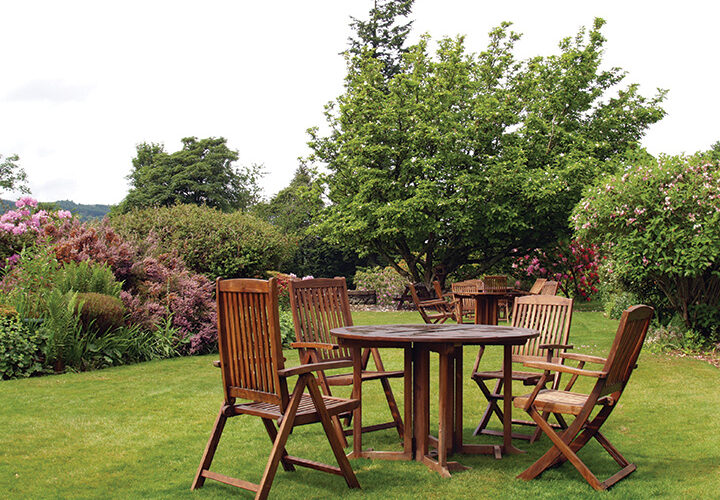BY BOB ANDERSON
Owning teak patio furniture is like owning a wooden boat: during the off-season you must do something to maintain it. Teak furniture – along with Cedar, Mahogany and Ipe (a.k.a Ironwood) – can withstand more abuse and weather than other types of furniture, but the one thing it can’t withstand is neglect. Teak is unique compared to other furniture materials because, by design, it can be easily maintained, restored and repaired to last a lifetime. It does not have to be the time-and-money-consuming nightmare that would make a person regret owning it with a few, time-tested products and techniques or the services of an experienced, professional restorer.
Ease-of-care starts before you buy it. Outdoor teak is an oiled wood that must never be stained or varnished! Teak contains natural oils with dense, tight grain that makes it resistant to insects and fungi, an application of Teak Oil or a sealer is all it needs. Stains and varnishes do not last long outdoors, they eventually crack and peel while remaining stubbornly affixed in adjacent areas making it necessary to, and extremely difficult to, remove. Avoid stained or varnished teak furniture and do not apply these finishes yourself. The furniture dealer might not tell you that an oil or sealer must be applied immediately after purchase (they might not know it, either) or water and food stains can quickly occur. The benefit of covering the furniture, especially in the off-season, cannot be overstated! At the very least, store it protected from direct sunlight and weather.
If your furniture is gray, moldy or weather-worn, do not worry, there is beautiful furniture under all of that. Most of it can be removed with a power washer. Alternately, teak cleaner products are available on-line that work well with a little water and a brush. Rough, cracked (and varnished) wood requires sanding with 60-80 grit sandpaper and an orbital sander or 120-150 grit for light sanding and finishing after the coarser grit. Also, hammer in the dowels and tighten all the hardware since they mysteriously loosen themselves. Whether new or recently sanded, teak should have the smooth, familiar feel of human skin.
The saying “teak dulls to an attractive, gray patina” is maddening since that gray color is oxidation, a form of deterioration and is definitely undesirable. Neglected furniture may have mold and fungus on it and is hardly inviting although well-dressed people sit on it all the time – gross! There are several products to protect the wood. Teak Oil is readily available at hardware or paint stores, it looks great and helps hydrate the wood but lasts only a few months when exposed to sun and weather so it must be re-applied “seasonally” every 3-4 months. Since Teak Oil consists of 10% lacquer, it must not be over-applied then the excess wiped dry with a rag to prevent a glossy layer of lacquer. Teak sealer (like SEMCO ‘classic brown’), also used on the teak decks of yachts, is a better choice and last anywhere from a year to years longer than oil. Either can be applied with an inexpensive foam brush.
Teak is the luxurious gold-standard for outdoor furniture. With a little, regular care it can provide beauty and enjoyment for 75 years or more. And, if like with a wooden boat, you want to spend your leisure-time enjoying it rather than maintaining it, hire a teak furniture restorer who knows as much about what not to do as what is appropriate so it can be enjoyed for a lifetime and passed down to your heirs.
Bob Anderson operates Teak Revival, a teak furniture restoration service. If you have questions about teak care or to inquire about restoration services, contact him through his website at teakrevival.com

